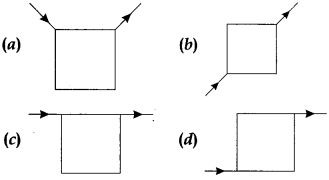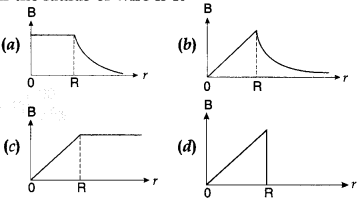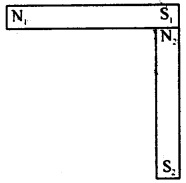Moving Charges And Magnetism
Class 12th Physics Chapter MCQs
Moving Charges and Magnetism Class 12 Physics MCQs
1. A charged particle is moving in a cyclotron, what effect on the radius of
path of this charged particle will occur when the frequency of the ratio
frequency field is doubled?
(a) It will also be doubled.
(b) It will be
halved.
(c) It will be increased by four times.
(d) It will remain
unchanged.
Answer
Answer: d
2. Which of the following is not correct about cyclotron?
(a) It is a
machine to accelerate charged particles or ions to high energies.
(b)
Cyclotron uses both electric and magnetic fields in combination to increase the
energy of charged particles.
(c) The operation of the cyclotron is based on
the fact that the time for one revolution of an ion is independent of its speed
or radius of its orbit.
(d) The charged particles and ions in cyclotron can
move on any arbitrary path.
Answer
Answer: d
3. If an electron is moving with velocity \(\vec{ν}\) produces a magnetic
field \(\vec{B}\), then
(a) the direction of field \(\vec{B}\) will be same
as the direction of velocity \(\vec{ν}\) .
(b) the direction of field
\(\vec{B}\) will be opposite to the direction of velocity \(\vec{ν}\) .
(c)
the direction of field \(\vec{B}\) will be perpendicular to the direction of
velocity \(\vec{ν}\) .
(d) the direction of field \(\vec{B}\) does not depend
upon the direction of velocity \(\vec{ν}\) .
Answer
Answer: c
4. Current flows through uniform, square frames as shown in the figure. In
which case is the magnetic field at the centre of the frame not zero?
Answer
Answer: c
5. Ampere’s circuital law is given by
Answer
Answer: b
6. Two identical current carrying coaxial loops, carry current I in opposite
sense. A simple amperian loop passes through both of them once. Calling the loop
as C, then which statement is correct?
(c) there may be a point on C where B and dl are
parallel.
(d) none of these
Answer
Answer: b
7. The correct plot of the magnitude of magnetic field \(\vec{B}\) vs
distance r from centre of the wire is, if the radius of wire is R
Answer
Answer: b
8. The nature of parallel and anti-parallel currents are
(a) parallel
currents repel and antiparallel cur¬rents attract.
(b) parallel currents
attract and antiparallel cur-rents repel.
(c) both currents attract. ’
(d)
both currents repel.
Answer
Answer: b
9. The magnetic moment of a current I carrying circular coil of radius r and
number of turns N varies as
(a) \(\frac{1}{r²}\)
(b) \(\frac{1}{r}\)
(c) r
(d) r²
Answer
Answer: d
10. A short bar magnet has a magnetic moment of 0. 65 J T-1, then
the magnitude and direction of the magnetic field produced by the magnet at a
distance 8 cm from the centre of magnet on the axis is
(a) 2.5 ×
10-4 T, along NS direction
(b) 2.5 × 10-4 T along SN
direction
(c) 4.5 × 10-4 T, along NS direction
(d) 4.5 ×
10-4 T, along SN direction
Answer
Answer: b
11. A current carrying loop is placed in a uniform magnetic field. The torqe
acting on it does not depend upon
(a) area of loop
(b) value of
current
(c) magnetic field
(d) None of these
Answer
Answer: d
12. In a moving coil galvanometer the deflection (Φ) on the scale by a
pointer attached to the spring is
Answer
Answer: c
13. A moving coil galvanometer can be converted into an ammeter by
(a)
introducing a shunt resistance of large value in series.
(b) introducing a
shunt resistance of small value in parallel.
(c) introducing a resistance of
small value in series.
(d) introducing a resistance of large value in
parallel.
Answer
Answer: b
14. The conversion of a moving coil galvanometer into a voltmeter is done
by
(a) introducing a resistance of large value in series.
(b) introducing
a resistance of small value in parallel.
(c) introducing a resistance of
large value in parallel.
(d) introducing a resistance of small value in
series.
Answer
Answer: a
15. When a magnetic compass needle is carried nearby to a straight wire
carrying current, then
(I) the straight wire cause a noticeable deflection in
the compass needle.
(II) the alignment of the needle is tangential to an
imaginary circle with straight wire as its centre and has a plane perpendicular
to the wire
(a) (I) is correct
(b) (II) is correct
(c) both (I) and
(II) are correct
(d) neither (I) nor (II) is
correct
Answer
Answer: c
16. A strong magnetic field is applied on a stationary electron. Then the
electron
(a) moves in the direction of the field.
(b) remained
stationary.
(c) moves perpendicular to the direction of the field.
(d)
moves opposite to the direction of the field.
Answer
Answer: b
17. In an inertial frame of reference, the magnetic force on a moving charged
particle is \(\vec{F}\) Its value in another inertial frame of reference will
be
(a) remained same
(b) changed due to change in the amount of charge
(c) changed due to change in velocity of charged particle
(d) changed due to
change in field direction
Answer
Answer: c
18. Which one of the following is correct statement about magnetic
forces?
(a) Magnetic forces always obey Newton’s third law.
(b) Magnetic
forces do not obey Newton’s third law.
(c) For very high current, magnetic
forces obey Newton’s third law.
(d) Inside low magnetic field, magnetic
forces obey Newton’s third law.
Answer
Answer: b
19. A charged particle is moving on circular path with velocity v in a
uniform magnetic field B, if the velocity of the charged particle is doubled and
strength of magnetic field is halved, then radius becomes
(a) 8 times
(b)
4 times
(c) 2 times
(d) 16 times
Answer
Answer: b
20. Two a-particles have the ratio of their velocities as 3 : 2 on entering
the field. If they move in different circular paths, then the ratio of the radii
of their paths is
(a) 2 : 3
(b) 3 : 2
(c) 9 : 4
(d) 4 :
9
Answer
Answer: b
Question 21.
The current sensitibility of a moving coil galanometer
increases with decrease in:
(a) magnetic field
(b) area of a coil
(c)
number of turns
(d) None of these
Answer
Answer: (d) None of these
Question 22.
A current carring coil is placed in a uniform magnetic field.
If the coil turns through an angle θ, then the torque is directly proportional
to:
(a) sin θ
(b) cos θ
(c) cot θ
(d) tan θ
Answer
Answer: (b) cos θ
Question 23.
The sensitivity of a tangent galvanometer can be increased by
increasing:
(a) the radius of the coil
(b) the external magnetic field
(c) the number of turns of the coil
(d) all the above
Answer
Answer: (b) the external magnetic field
Question 24.
The permeability of a paramagnetic substance is:
(a) very
large
(b) small but more than unity
(c) less than unity
(d)
negative
Answer
Answer: (b) small but more than unity
Question 25.
Which of the following shows that the earth behaves as a
magnet?
(a) Repulsion between like poles .
(b) Attraction between unlike
poles
(c) Null points in the magnetic field of a bar magnet
(d) No
existence of isolated magnetic poles
Answer
Answer: (c) Null points in the magnetic field of a bar magnet
Question 26.
What is the angle of dip at the magnetic poles ?
(a)
30°
(b) 0°
(c) 45°
(d) None of these
Answer
Answer: (d) None of these
Question 27.
A charged particle of mass m and charge q travels on a
circular path of radius r i.e., perpendicular to the magnetic field B. The time
taken by particle to complete on revolution is :
(a) \(\frac{2πqB}{m}\)
(b) \(\frac{2πm}{qB}\)
(c) \(\frac{2πmq}{B}\)
(d) \(\frac{2πq^2B}{m}\)
Answer
Answer: (b) \(\frac{2πm}{qB}\)
Question 28.
Circular loop of radius 0.0157 m carries a current 2 A. The
magnetic field at the centre of the loop is :
(a) 1.57 ×
10-3Wb/m²
(b) 8.0 × 10-5 Wb/m²
(c) 2.0 ×
10-3 Wb/m²
(d) 3.l4 × 10-1
Wb/m²
Answer
Answer: (b) 8.0 × 10-5 Wb/m²
Question 29.
What happens to the magnetic field at the centre of a circular
current carrying coil if we double the radius of the coil keeping the current
unchanged?
(a) halved
(b) doubled
(c) quadrupled
(d) remains
unchanged
Answer
Answer: (a) halved
Question 30.
When we double the radius of a coil keeping the current
through it unchanged, what happens to the magnetic field directed along its axis
at far off points?
(a) halved
(b) doubled
(c) quadrupled
(d) remains
unchanged
Answer
Answer: (d) remains unchanged
Question 31.
The strength of the magnetic field around an infinite current
carrying conductor is :
(a) same everywhere
(b) inversely proportional to
the distance
(c) directly proportional to the distance
(d) None of
these
Answer
Answer: (b) inversely proportional to the distance
Question 32.
A current carrying power line carries current from west to
east. Then the direction of the magnetic field 2 m above it is :
(a) west to
east
(b) south to north
(c) north to south
(d) None of
these
Answer
Answer: (c) north to south
Question 33.
According to Ampere’s Circuital law
Answer
Answer: (b)
Question 34.
The force between two parallel current carrying conductors is
F. If the current in each conductor is doubled, then the force between them
becomes :
(a) 4F
(b) 2F
(c) F
(d)
\(\frac{F}{4}\)
Answer
Answer: (a) 4F
Question 35.
How much force will be experienced by a moving charge in a
magnetic field? The symbols have their usual meanings.
(a) \(\vec{F}\) =
q(\(\vec{v}\).\(\vec{B}\))
(b) \(\vec{F}\) =
\(\frac{q}{(\vec{v}.\vec{B})}\)
(c) \(\vec{F}\) =
\(\frac{q}{2}\)\((\vec{v}×\vec{B}\))
(d) \(\vec{F}\) =
q(\(\vec{v}\)×\(\vec{B}\))
Answer
Answer: (d) \(\vec{F}\) = q(\(\vec{v}\)×\(\vec{B}\))
Question 36.
Which of the following is not a unit of magnetic
induction?
(a) gauss
(b) tesla
(c) oersted
(d)
weber/metre²
Answer
Answer: (c) oersted
Question 37.
The magnetic field produced by an / meter long straight (x
cry thin) current (I) carry ing conductor at any point on itself is :
(a)
zero
(b) infinite
(c) \(\frac{µ_0l}{4πl}\)
(d)
\(\frac{µ_0l}{2πl}\)
Answer
Answer: (a) zero
Question 38.
A charge + q is sent through a magnetic field. The force
acting on it is maximum w hen the angle between the direction of motion of the
charged particle and the magnetic field :
(a) 0°
(b) 45°
(c) 90°
(d)
180°
Answer
Answer: (c) 90°
Question 39.
An electron having mass ‘m’ and Kinetic energy E enters in
uniform magnetic field B perpendicular, then its frequency will be:
(a)
\(\frac{eE}{qmB}\)
(b) \(\frac{2πm}{eB}\)
(c) \(\frac{eB}{2πm}\)
(d)
\(\frac{2m}{eBE}\)
Answer
Answer: (c) \(\frac{eB}{2πm}\)
Question 40.
A wire of length 2 metre carries a current 1 ampere, is bent
to form a circle. The magnetic moment of the coil is :
(a) 2π
(b) π/2
(c) π/4
(d) 1/π
Answer
Answer: (d) 1/π
Question 41.
The magnetic field of a given length of a ware for single
turn coil at its centre is B. Then.its value for two turns of coil will be :
(a) B/4
(b) B/2
(c) 4B
(d) 2B
Answer
Answer: (c) 4B
Question 42.
When charged particle enters-a uniform magnetic field, its
K.E.:
(a) remains constant
(b) increases
(c) decreases
(d) becomes
zero
Answer
Answer: (a) remains constant
Question 43.
To convert galvanometer into voltmeter one should connect
:
(a) high resistance in series with galvanometer
(b) low resistance in
series with galvanometer
(c) high resistance in parallel with
galvanometer
(d) low resistance in parallel with
galvanometer
Answer
Answer: (a) high resistance in series with galvanometer
Question 44.
A charge q moves in a region, where electric field E and
magnetic field B both exist, then force on it is :
(a) \(\vec{F}\) =
q(\(\vec{v}\)×\(\vec{B}\))
(b) \(\vec{F}\) = q{\(\vec{E}\)×(\(\vec{v}\) ×
\(\vec{B}\))}
(c) \(\vec{F}\) = q(\(\vec{E}\) + (\(\vec{B}\) ×
\(\vec{v}\))
(d) \(\vec{F}\) = q(\(\vec{B}\) + (\(\vec{E}\)
×\(\vec{v}\))
Answer
Answer: (b) \(\vec{F}\) = q{\(\vec{E}\)×(\(\vec{v}\) × \(\vec{B}\))}
Question 45.
Isoclinic lines are the lines joining places with :
(a)
equal dip
(b) equal declination
(cj equal dip and declination
(d) None
of these
Answer
Answer: (a) equal dip
Question 46.
Two identical bar magnets each of dipole moment p and length
I are perpendicular to each other as shown in Fig. The dipole moment of the
combination is:
(a) √2 p
(b) \(\frac{p}{√2}\)
(c) P
(d) 2p
Answer
Answer: (a) √2 p
Question 47.
The most suitable metal for making permanent magnets is :
(a) iron
(b) steel
(c) copper
(d) aluminium
Answer
Answer: (b) steel
Question 48.
The SI unit of magnetic dipole moment is’
(a) Ampere
(b) Ampere metre²
(c) Tesla
(d) None of these
Answer
Answer: (b) Ampere metre²
Question 49.
Earth’s magnetism was discovered by:
(a) Gauss
(b)
Oersted
(c) Ampere
(d) Gilbert
Answer
Answer: (d) Gilbert
Question 50.
According to Gauss’s theorem in magnetism, surface integral
of magnetic field intensity over a surface (closed or open) is always:
(a)
-1
(b) 1
(c) 0
(d) infinity
Answer
Answer: (c) 0
Question 51.
Tesla is a unit of:
(a) electric flux
(b) magnetic
flux
(c) magnetic field
(d) electric field
Answer
Answer: (c) magnetic field
Question 52.
10 eV electron is circulating in a plane at right angle to a
uniform field of magnetic induction 10-1 Wb/m² (1G). The orbital
radius of electron is:
(a) 12 cm
(b) 16 cm
(c) 11 cm
(d) 18
cm
Answer
Answer: (c) 11 cm
Question 53.
A cyclotron can be used to produce high energy:
(a)
neutrons
(b) deutrons
(c) β particles
(d) α
partifcles
Answer
Answer: (d) α partifcles
Question 54.
The radius of the trajectory of a charged particle in a
uniform magnetic field is proportional to the:
(a) charge on the particle
(b) energy of the particle
(c) momentum of the particle
(d) all the
above
Answer
Answer: (c) momentum of the particle
Question 55.
The force \(\vec{F}\) experienced by a particle of charge q
moving with velocity \(\vec{v}\) in a magnetic field \(\vec{B}\) is given
by,
(a) \(\vec{F}\) = q(\(\vec{F}\) × \(\vec{B}\))
(b) \(\vec{F}\) =
q(\(\vec{B}\) × (\(\vec{b}\))
(c) \(\vec{F}\) = q(\(\vec{v}\) ×
(\(\vec{B}\))
(d) \(\vec{F}\) = q(\(\vec{v}\) ×
\(\vec{B}\))
Answer
Answer: (a) \(\vec{F}\) = q(\(\vec{F}\) × \(\vec{B}\))
Question 56.
The torque acting on a magnetic dipole of moment
\(\vec{p_m}\) when placed in a magnetic field \(\vec{B}\) is:
(a)
pmB
(b) \(\vec{p_m}\) × \(\vec{B}\)
(c)
\(\vec{p_m}\)\(\vec{B}\)
(d) \(\frac{p_m}{B}\)
Answer
Answer: (b) \(\vec{p_m}\) × \(\vec{B}\)
Question 57.
In thomson spectrograph \(\vec{E}\) ⊥ \(\vec{B}\), then
velocity of electron beam will be:
(a) |\(\vec{E}\)|/|\(\vec{B}\)|
(b)
\(\vec{E}\) × \(\vec{B}\)
(c) |\(\vec{B}\)|/|\(\vec{E}\)|
(d) E² /
B²
Answer
Answer: (a) |\(\vec{E}\)|/|\(\vec{B}\)|